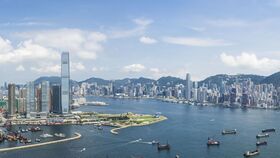Jinhae
Jinhae | |
|---|---|
|
Flag of Jinhae Flag | |
| Nickname(s): City of the West, World's Gateway. | |
| Motto(s): 새로운 동쪽의 관문. ("A New Gateway of the East.") | |
| Country | |
| Metropolitan Municipality | Jinhae Metropolitan Muicipality (coterminous) |
| Subdivisions | Districts
|
| Jinhae founded | c. 1554 AD |
| District Division | Metropolitan Municipality |
| Government | |
| • Type | Jinhae Metropolitan Assembly |
| • Elected body | Jinhae Metropolitan Assembly |
| • Mayor | Jinsu Choi (L) |
| • Senator | 5 Sangseowon Representatives |
| Area | |
| • City | 9,114.18 km2 (3,519.00 sq mi) |
| • Land | 8,785.16 km2 (3,391.97 sq mi) |
| • Water | 329.02 km2 (127.04 sq mi) |
| Highest elevation | 318.9 m (1,046.3 ft) |
| Lowest elevation | −1.6 m (−5.2 ft) |
| Population (2019) | |
| • Density | 1,652.9/km2 (4,281/sq mi) |
| • Metro | 15,064,561 |
| Demonym | Jinhaean |
| Time zone | UTC+08:00 (Zhenia Eastern Standard Zone (ZEST)) |
| ZIP Code | 00101-00190 |
| Zhenia Federal Area Code | JH |
| City Flower | Jin Orchid |
| Website | www.jinhaecity.zhen.gov |
Jinhae (Classic Zhenian: 辰海, Modern Zhenian: 진해), formally the Jinhae Metropolitan Municipality (Classic Zhenian: 辰海廣域市, Modern Zhenian: 진해광역시), is the second most populous city of the Republic of Zhenia. As one of the five Metropolitan Municipalities in Zhenia, it is governed by the Jinhae Metropolitan Government. It faces the Gulf of Zhen to the east and borders the provinces of Balhae, Changbaek and Imhae respectively. Being home to over 15 million residents and its metropolitan area altogether forming the Taimir Delta Megalopolis, Jinhae is a major hub for trade, transportation and finance, as well as the largest city in mainland Zhenia.
Originally a small fishing and trading outpost located just north of the delta of the Taimir River, what is now modern-day Jinhae grew into one of the most important cities in mainland Zhenia as it was selected as one of the first ten ports open to the Shindan dynasty in 1847 after the Treaty of Sanggyeong was ratified. Becoming a directly-governed city in the early days of the Zhenian Civil War, it became one of the centers of trade and the influx of goods, Zhenian migrants and investment into mainland Zhenia; by the end of the 19th century, it had already overtaken Junggyeong as the largest Zhenian city outside the Danguk Peninsula. Although the city was burned to the ground due to allied air strikes during the later stages of the Second Great War, it was rebuilt during the Third Zhenian Republic as a hub of trade and finance in mainland Zhenia, with major segments being redeveloped over the years.
Although its stance as the "second heart of Zhenia" is being challenged by Changan and Shinhang, Jinhae remains the largest city and hub in mainland Zhenia. The Port of Jinhae, with recent expansions, remains the largest container port in the nation, handling over 35 million TEUs in 2019, still being a major entrepot in modern commerce. It is also home to the annual Zhenia International Trade Exposition, the single largest trade fair in the nation.
Name
History
Geography
Climate
Situated just north of the Tropic of Cancer, Jinhae has a humid subtropical climate (Koppen Cfa). Due to it being under the influence of local monsoon winds, its monsoon seasons on average start earlier and end later than the much of the Golden Arc region, with monsoons starting in late April and ending by early October. The city experiences four distinct seasons, although its low temperatures rarely fall below freezing even under the influence of dry, cold continental winds in the winter. Its long summers are hot and humid, with most of it overlapping with the monsoon season.
| Jinhae, Zhenia | ||||||||||||||||||||||||||||||||||||||||||||||||||||||||||||
|---|---|---|---|---|---|---|---|---|---|---|---|---|---|---|---|---|---|---|---|---|---|---|---|---|---|---|---|---|---|---|---|---|---|---|---|---|---|---|---|---|---|---|---|---|---|---|---|---|---|---|---|---|---|---|---|---|---|---|---|---|
| Climate chart (explanation) | ||||||||||||||||||||||||||||||||||||||||||||||||||||||||||||
| ||||||||||||||||||||||||||||||||||||||||||||||||||||||||||||
| ||||||||||||||||||||||||||||||||||||||||||||||||||||||||||||




